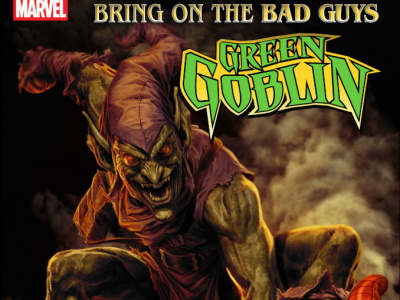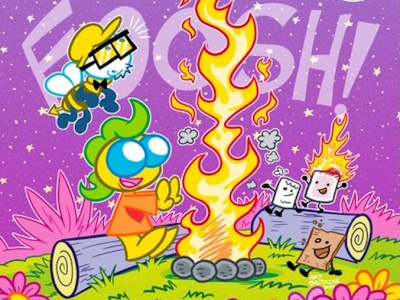 ICv2 got a chance to talk to DC Co-Publishers Dan Didio and Jim Lee last month in our annual conversation about the state of the market and DC’s place in it. This year’s conversation comes at a critical time for DC, as it re-launches its entire line and expands its digital strategy. In Part 2, we talk about the connections between DC and Warners, and the different aspects of event fatigue. In Part 3, we talked about the move to digital release at the same time as print, comics for kids, and media drivers of sales. And in Part 1, we talked about the market conditions that led DC to its decisions, the reactions to its price cuts, and the full line relaunch.
ICv2 got a chance to talk to DC Co-Publishers Dan Didio and Jim Lee last month in our annual conversation about the state of the market and DC’s place in it. This year’s conversation comes at a critical time for DC, as it re-launches its entire line and expands its digital strategy. In Part 2, we talk about the connections between DC and Warners, and the different aspects of event fatigue. In Part 3, we talked about the move to digital release at the same time as print, comics for kids, and media drivers of sales. And in Part 1, we talked about the market conditions that led DC to its decisions, the reactions to its price cuts, and the full line relaunch.Jim, you mentioned Superman and the focus there. Given the new, closer connections between DC and Warner Brothers over the last year and a half, what steps are being taken, if any, to coordinate this new look at Superman with the movie that’s currently on the way from Zach Snyder, and perhaps with any television. Is there closer coordination now than there would have been a couple of years ago in terms of making all the versions of the character fit well together?
Lee: There’s definitely closer communication; in terms of coordination, that’s a stronger word. When I say communication, obviously when we make changes like this to iconic characters other departments and divisions within Warner Brothers know what’s happening on a creative level. That said, this is not about us taking initial steps to redefine the character for all media. This is a publishing initiative. The September relaunch is all about keeping the characters that are in print and in digital comic books as exciting and contemporary as possible.
We saw a lot of excitement for Superman with the “Grounded” story line, with the Earth One story line. We know that the fans love these characters and we felt that in some ways, we might have been taking these characters a little for granted, and we want to show that we still have a lot of surprises and mileage out of them. We thought with the creative team that we have with Rags Morales and Grant Morrison, that they could deliver on some of the changes we want to make in the mythology.
But getting back to your question, this is a strategy that Warner Brothers is informed on, but none of these changes were designed to set the stage for other media exploitation of the same ideas. When you look at film, animation, video games, they really look at the vast catalogue of DC characters and stories and pick out what appeals to that film-maker or that game developer and then they choose to focus on that creative part of a character’s history. And that’s why you have so many different interpretations of some of these core characters. But at the end of the day, everyone knows that they’re Batman, or Superman or Wonder Woman.
We felt incumbent upon us as co-publishers that we needed to drive as much interest in the characters as they originally started out with as published characters. We felt that the plans we have for September maximize our ability to drive interest in the characters and that we had this once in a lifetime opportunity to remold them in a way that would pay greater dividends down the line.
One of the things comics retailers have been saying a lot over the past six months is that there’s a real “event fatigue” among their fan base and that the events that tie together many books in a publisher’s line. They’re having more trouble selling those and getting people to buy in for all of it. Flashpoint, we’ve heard is selling well, some of the miniseries maybe not as well as people expected. What are you going to be doing, New 52 and beyond, in terms of events and their scale? Do you see this event fatigue and are you trying to respond to that in any way?
Didio: First things first. What retailers have identified as event fatigue is usually what we see as a weak story that is not exciting or interesting to the fans themselves.
We were trying not to say that… (laughter)
Didio: No—that’s the reality of it. The reality of it is that “event fatigue” only means that they don’t like what they’re reading. It doesn’t mean that they’re tired of big stories, or tired of multi-part crossovers. They just want to make sure that it has value and weight.
You mentioned about Flashpoint, but quite honestly, we’re seeing the exact opposite. Flashpoint is doing everything we hoped it was going to do. The numbers are just where they thought they were going to be, and more importantly, that we’ve had sell-outs on a couple of those issues that we thought about going back to press on. Even Flashpoint #1 has gone back to press twice, so we have lots of faith in that particular book of where we stand with that series. Can’t speak for every publisher along those lines, but I certainly can speak for ourselves that we’re happy with the way Flashpoint’s turned out.
Now when we get to 52, people are identifying this as an event and this is not an event, therefore I guess they can’t get fatigued. Quite honestly this is an issue across the entire company designed to realign the types the stories, the types of books we use, as well the way we plan to distribute and work as a company. There’s a lot more going on here than deeming 52 as an event. We don’t consider these 52 new series an event, we consider this a new company initiative designed to really reinvigorate the industry, not just to spike sales.
In the post-New 52 world, will you be handling events in the same way—in the same scale, lots of miniseries—or are you going to handle things differently?
Didio: We’re trying to keep the number of products that we’re doing to a manageable base. One of the things that we’ve also seen is the need to overproduce to compensate for weakening sales and that’s something that we’re trying to stay away from. And across our entire line, between the DC Comics products, the Vertigo product as well the support books that we do with the kids’ books and the license in product. We don’t want to put out more than 80 to 85 titles a month, which is less than what we’re doing now, but we feel it’s a sustainable amount for quality and with the level of interest that we hope that we get from the fans.
Lee: Our strategy is not to garner as much market share as possible. I think our approach is to give creators the most bang for their buck both financially and creatively. When we start thinking about events the guiding rule at hand has to be if you create an event, it has to be creatively driven. You can’t just decide you’re going to exploit a book across all these titles to have no impact upon what you’re trying to tell on a story level. I think if we stick to that approach, our readers are ultimately going to be happier and our events are going to be ultimately more successful.
One of the themes that we heard from retailers after the announcement of the New 52 was that there was some cynicism among their customers whether the changes would be long lasting, whether the numbering would hold at the low numbers. What’s your response to those kinds of concerns?
Didio: I can understand why people get concerned and why you would have that certain level of cynicism because they’ve seen the industry turn over and over again. We’re extraordinarily committed to this process, we’re extraordinarily committed to this initiative, and as far as I’m in this position, I see this being the company strategy moving forward with no looking back.
Lee: I think cynicism on the Internet, that’s not particularly shocking…
Didio: Like gambling in Casablanca…
Lee: I think what’s interesting to note is that fans are very fickle, so I know that as many people who are skeptical of what’s going on in September will be as persuaded to love it if we do our jobs right. I read the same message boards. I hear the same criticisms, but at the end of the day, you‘ve got to go with your gut instinct on this. You’ve got to go with what you think is the best creative, and I hope that fans and readership feel the same way. I think they will.
It’s almost a little un-hip to approach something that hasn’t been put out yet with open arms and excitement. That said, as we’ve done these road shows and talked to retailers from one end of the country to the other, and then going into San Diego Comic-Con and New York Comic Con, I really do expect through word of mouth, through our presentations, through our discussions and interactions with fans, to really show them the level of passion and commitment we have to what we’re doing in September and get them excited about what we’re doing.
I think that part of what’s missing on the Internet, is that kind of one-to-one interaction, that kind of hand selling. If we do that, as the books come out and fans get to actually read the stories we’ve been talking about, I think you’ll have a very different attitude towards what we’re doing in September and going forward. A lot less cynicism, and more understanding and acceptance and excitement for what we have planned.
Click here for Part 3.







